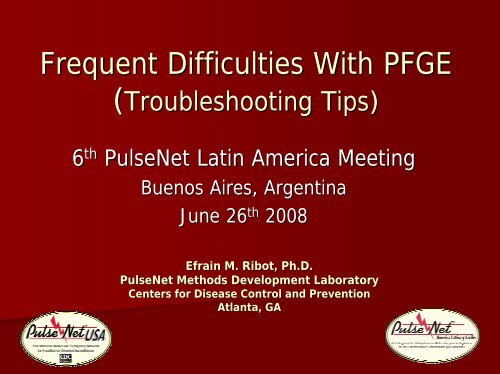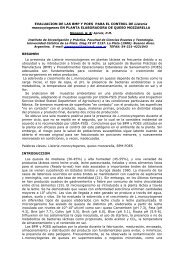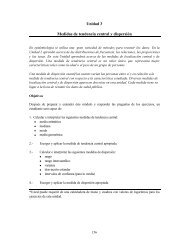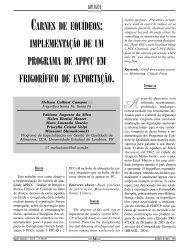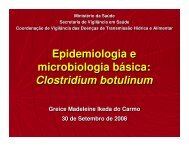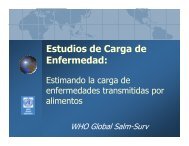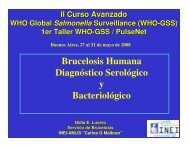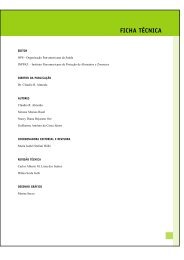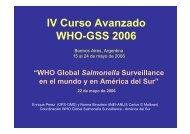Frequent Difficulties With PFGE - Inocuidade de Alimentos
Frequent Difficulties With PFGE - Inocuidade de Alimentos
Frequent Difficulties With PFGE - Inocuidade de Alimentos
- No tags were found...
You also want an ePaper? Increase the reach of your titles
YUMPU automatically turns print PDFs into web optimized ePapers that Google loves.
<strong>Frequent</strong> <strong>Difficulties</strong> <strong>With</strong> <strong>PFGE</strong>(Troubleshooting Tips)6 th PulseNet Latin America MeetingBuenos Aires, ArgentinaJune 26 th 2008Efrain M. Ribot, Ph.D.PulseNet Methods Development LaboratoryCenters for Disease Control and PreventionAtlanta, GA
Troubleshooting <strong>PFGE</strong> Gels• Consi<strong>de</strong>r all steps in protocol:• Preparation of cell suspensions• Preparation of <strong>PFGE</strong> plugs• Lysis of cells in <strong>PFGE</strong> plugs• Washing of <strong>PFGE</strong> plugs• Restriction digestion of DNA• Electrophoresis of restricted DNA• Documentation of <strong>PFGE</strong> gel• Equipment performance• Changes in laboratory practices, vendors,reagent preparers, etc.
Water Quality• Make sure the quality of water used forreagents is the best possible.• Change filters in water system on regular basis.• Use sterile ultrapure (Type I or ReagentGra<strong>de</strong>) water for all reagents.• Non-sterileultrapure water can be used for:• Buffer used to make gels.• Electrophoresis running buffer• De-staining gels
Non-selectiveMediaCulture GrowthSelectiveMedia0.35 0.45 0.6 0.35 0.45 0.6Cellsuspension18 hrs48 hrs• Grow cultures on non-selective media• Plugs should be ma<strong>de</strong> from fresh cultures– 14-18 18 hours old• Prepare Campylobacter plugs as soon as culture is readyto limit exposure of the organism to oxygen
Cell Suspension Preparation• Mix cell suspension well,but DO NOT VORTEX• Check concentrationvalue at least twice• More (higherconcentration of cells) isnot always better.
Plug Preparation• Equilibrate melted agarose to50-5454º C• Limit mechanical force(pipetting)) when mixingmelted agarose with cellsuspensions• Do not re-use plug agarosemore than 3-434 times, sincerepeated heating results inloss of fluid and increasesthe agarose concentration
Lysis• Make “master mixes” for Cell Lysis Buffer andProteinase K• Lyse plugs in a shaking water bath or incubatorat 54º C.• Use no less than 5ml of lysis buffer per isolate.• Follow lysis time recommen<strong>de</strong>d in the protocolfor the organism being tested.
Plug Washing:To remove Impurities that may inhibitrestriction digestionIna<strong>de</strong>quate WashingWashing two additional times• Perform washes in no less 10-15 15 ml to allowimpurities to diffuse out.• At least 2 water washes and 4 TE washes• Wash at 50ºC in a shaking water bath or incubator
Preparing Plug Slices forRestriction Digestion• Be consistent with thesize of plug slices used• Use a sharp tool or <strong>de</strong>vicecut plugs with• Plugs cut too small caneasily be damaged andresult in band distortions.• Plug cut too large canresult in thick indistinctbands that are difficult toanalyze.PlugSlices1 mmDamagedPlug Slices
Preparing Plug Slices forRestriction DigestionH9812 Double Digest -Enzyme notinactivated prior to gel loading• Always use mastermixes when preparingenzyme mixtures• Routinely check waterbath temperatures• Incubate with 0.5 XTBE to inactivateenzyme
Restriction of DNAIncompleteComplete• Incomplete restriction(shadow or ghost bands) isoften associated withimpurities not removedduring washing (i.e.proteinase K)• Incomplete restriction couldbe related to specific lots ofenzymes or impurities inwater used to preparerestriction mixture
More on Incomplete RestrictionOther reasons for incomplete restriction:• Poor plug quality – SDS, Proteinase K,Sarcosine were not removed from plug.• Concentration of DNA was too high.• Concentration of enzyme was too low.• Wrong incubation temperature or buffer.• Plug slice was not un<strong>de</strong>r restriction mixture.• Bad lot of enzyme and/or buffer.• Restrict <strong>PFGE</strong> plug slice of the standardstrain or other sample that previously gavea clean pattern to check.
Casting Agarose Gel• Level gel form before gel is poured.• Position of comb is important.• If plugs are loa<strong>de</strong>d into wells, position comb2-mm above black platform.• If plug slices are loa<strong>de</strong>d on comb, positioncomb and plug slices so they are flushagainst black platform.• Be sure plug slice is not curved or at an angle.• Do not disturb gel after it is poured and whilestill liquid. Remove bubbles or lint with cleanpipette tip immediately after gel is poured.
Loading plugs
Casting of Gel• Pour melted agarose (equilibrated to~54°C) slowly from bottom center of gel• Allow agarose to polymerize at least 30minutes• Remove comb• Fill in wells with melted agarose – optional• Place gel into electrophoresis chamber
Electrophoresis• Check milliamperes (mA)) atstart of run.• If mA value is high (>165):– Buffer dilution or formulationproblems.– Water used to prepare 0.5XTBE buffer is of poor quality.• If mA value is low (
Run Times• Bottom band (20.5 Kb) of the standard shouldbe 1-1.511.5 mm from the bottom of the gel• If the run time is too short• Pattern is compressed• Decreased resolution of closely migrating bands• Normalization of the pattern may be compromised• If the run time is too long• Bottom band of the standard runs off the gel• Unable to perform normalization
Run Times• Electrophoresis run time may vary from…• Lab to Lab• Equipment to Equipment• Person to Person• Month to Month• Critical factors that effect run times• Composition in 0.5X TBE• Commercial vs. In-house• Buffer pH• Buffer temperature• Ambient temperature• Length of tubing• Gel concentration
Wrong Running Condition• A Salmonella gel run withE. coli running conditions• May not notice untilperforming analysis• Gel must be rerun toensure proper resolutionof fragments fromorganism of interest
Wrong Running ConditionPay attention to distortion bars!!!!!
Electrophoresis• Remove bubbles in the buffer lines.• The circulation and cooling of buffer will beaffected (temperature could rise).• Ice in the line can also affect the circulationand cooling of buffer.• Cut tubing connecting electrophoresiscell and pump to length recommen<strong>de</strong>din the instruction manuals.• Eliminate kinks in the tubing.
More About Electrophoresis• Remove small pieces of agarose from top ofgel trap and electrophoresis chamber whenbuffer is drained.• If gel trap is not flush with bottom of chamber,small pieces of agarose can circulate throughthe lines and clog the drain port(s).• May affect buffer circulation.• Replace gel traps with broken “feet. feet.”• Rinse chamber and lines with Type I Water toremove residual buffer after runs.
Gel Staining• Stain in Ethidium Bromi<strong>de</strong> solution• 40 µl l of 10 mg/ml stock solution per 400 ml• Stain gel on rocker for 25-30 minutes• Remove stain and <strong>de</strong>-stain with ≈500 ml• Change water at least three times every15-20 minutes.
Image Acquisition• Take measuresto ensure theimage is in focus• Focus thecamera on thelines of a ruler
Image Acquisition• Avoid over-integration of the image– Reduces background– Makes closely migrating bandsmore distinct• Process– If available, select “Highlightsaturated pixels”– Saturated areas will appear red– Adjust integration time or theaperature until all red is removed– Saturation may remain in the wells• Areas on the gel may appearslightly faint to the naked eye, butwill be apparent when analyzing inBioNumerics
Image AcquisitionFile Conversion for GelDoc EQ and XR(Quantity One Software – version 4.5.0 or higher).Some value thatwhen you hit“enter” convertsthe file size to~300 Kb
Confirm Focus of CameraNot FocusedFocused
Bovine Serum Albumin• BSA is used to maintain enzyme stabilityduring the restriction digestion• Use acetylated or molecular gra<strong>de</strong> formolecular biology applications.• Diluted to a final concentration of 1X• Minimizes enzyme inactivation due toinhibitors.• Prevents enzymes from adhering to wall ofreaction tubes.• BSA can be ad<strong>de</strong>d to reaction mixtureseven when not recommen<strong>de</strong>d by thevendor.
What are “Untypeable” Strains?• Some isolates only give a “smear” on gel andare consi<strong>de</strong>red to be “untypeable” by <strong>PFGE</strong>.• Not able to <strong>de</strong>termine if related isolates havethe same or different <strong>PFGE</strong> patterns.• No information for epi<strong>de</strong>miological studies.• First observed at CDC with E. coli O157:H7Phage Type 31 strains
Un-typeableStrainsThiourea• Addition of 50 µM thiourea in the electrophoresis buffer(0.5X TBE)• Use only when nee<strong>de</strong>d (with known or suspected untypablestrains)• Safety concerns• Not a substitute for poor quality plugs
Examples of “Untypeable” Strains• O157:H7 Phage Type 31 strains• Some serotypes of Salmonella - Ohio, Panama,Saintpaul, , Kentucky, and Livingston,• Some strains of various Salmonella serotypes.• Newport, Miami, and others that usually type with<strong>PFGE</strong>.• Other bacteria inclu<strong>de</strong>:• Clostridia• Vibrio species• Pseudomonas aeruginosa• Klebsiella
Precautions• Adding thiourea to the running buffer will notsolve the problems of poor plug preparation.• Do not use on routine gels unless necessary.• Inclu<strong>de</strong> a positive control on gel.• Restricted <strong>PFGE</strong> plug slice of “untypeable”strain that “typed” previously when thioureawas used in buffer.• Long term effects on the electrophoresischamber, tubing and connections are notknown.
Pre-test <strong>PFGE</strong> Plugs of H9812, thePulseNet Standard Strain• Always test “new” lot of standard plugs with “old” lot toconfirm:• <strong>PFGE</strong> pattern is same, including intensity of bands.• The new standards produce good quality <strong>PFGE</strong>pattern• Pre-tested H9812 standard plugs can serve as a(+) control for XbaI restrictions and focus troubleshootingefforts.• If problem observed in sample lanes but not in standards, is wasdue to something that only effects the sample (i.e. sample plugpreparation)• If problem is observed in both sample and standard lanes, it isdue to a step involving sample and standard plugs (i.e. restrictioniondigests)
Electrophoresis ChamberContamination• Electrophoresis unit was probablycontaminated with bacteria or fungi.• Pseudomonas species isolated fromCDC unit.• To eliminate contamination:• Circulate 2 liters of a 5%-10%solution of bleach throughelectrophoresis chamber and tubingfor 30 minutes. Do not turn on chiller.• Drain bleach solution from chamber.• Circulate 2 liters of Type 1 water for15-30 minutes through chamber andtubing (2X).• Run gel with λ lad<strong>de</strong>r, yeastchromosomes, and/or <strong>PFGE</strong> plugstested previously
Send Your TroubleshootingQuestions via e-mail eto:PulseNet <strong>PFGE</strong> In BoxWrite “Troubleshooting” in thesubject line of e-mail emessage


